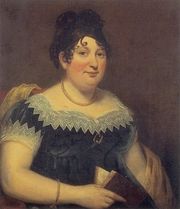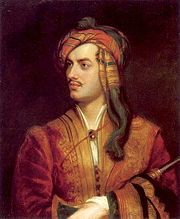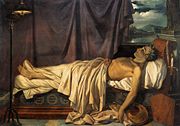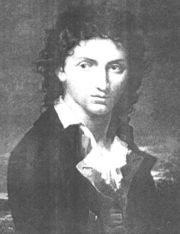George Gordon Byron, 6th Baron Byron
2008/9 Schools Wikipedia Selection. Related subjects: Writers and critics
| Lord Byron | |
|---|---|
 |
|
| Born | 22 January 1788 London, England |
| Died | 19 April 1824 (aged 36) Messolonghi, Greece |
| Occupation | Poet, revolutionary |
|
Influences
|
|
|
Influenced
|
|
George Gordon Byron, later Noel, 6th Baron Byron FRS ( 22 January 1788– 19 April 1824) was an English poet and a leading figure in Romanticism.
Amongst Byron's best-known works are the brief poems " She walks in beauty," and " So, we'll go no more a-roving," and the narrative poems Childe Harold's Pilgrimage and Don Juan, although the latter remained incomplete on his death. He is regarded as one of the greatest European poets and remains widely read and influential, both in the English-speaking world and beyond.
Byron's fame rests not only on his writings but also on his life, which featured extravagant living, numerous love affairs, debts, separation, and marital exploits. He was famously described by Lady Caroline Lamb as "mad, bad, and dangerous to know."
Byron served as a regional leader of Italy's revolutionary organization the Carbonari in its struggle against Austria. He later travelled to fight against the Ottoman Empire in the Greek War of Independence, for which Greeks revere him as a national hero. He died from a fever in Messolonghi in Greece.
Early life
Byron was born in a house on Hollis Street in London, the son of Captain John "Mad Jack" Byron and his second wife, the former Catherine Gordon, heiress of Gight in Aberdeenshire, Scotland. John Byron had circumnavigated the globe and was the younger brother of the 5th Baron Byron, known as "the Wicked Lord." Byron's paternal grandparents were Vice-Admiral John "Foulweather Jack" Byron and Sophia Trevanion.
He was christened George Gordon at St Marylebone Parish Church, after his maternal grandfather, George Gordon of Gight, a descendant of King James I. This grandfather committed suicide in 1779. Byron's mother Catherine had to sell her land and title to pay her father's debts. John Byron may have married Catherine for her money and, after squandering it, deserted her. Catherine regularly experienced mood swings and bouts of melancholy.
Catherine moved back to Scotland shortly afterward, where she raised her son in Aberdeen. On 21 May 1798, the death of Byron's great-uncle, the "wicked" Lord Byron, made the 10-year-old the 6th Baron Byron, inheriting the title and estate, Newstead Abbey, in Nottinghamshire, England. His mother proudly took him to England. Byron only lived at his estate infrequently as the Abbey was rented to Lord Grey de Ruthyn, among others, during Byron's adolescence.
In August 1799, Byron entered the school of William Glennie, an Aberdonian in Dulwich. Byron would later say that around this time and beginning when he still lived in Scotland, his governess, May Gray, would come to bed with him at night and "play tricks with his person." According to Byron, this "caused the anticipated melancholy of my thoughts--having anticipated life." Gray was dismissed for allegedly beating Byron when he was 11.
Byron received his early formal education at Aberdeen Grammar School. In 1801 he was sent to Harrow, where he remained until July 1805. He represented Harrow during the very first Eton v Harrow cricket match at Lord's in 1805. After school he went on to Trinity College, Cambridge.
Name
Byron's names changed throughout his life. He was christened George Gordon Byron in London. "Gordon" was a baptismal name, not a surname, honouring his maternal grandfather. In order to claim his wife's estate in Scotland, Byron's father took the additional surname Gordon, becoming John Byron Gordon, and he was occasionally styled John Byron Gordon of Gight. Byron himself used this surname for a time and was registered at school in Aberdeen as George Byron Gordon. At the age of 10, he inherited the English Barony of Byron, becoming Lord Byron, and eventually dropped the double surname (though after this point his surname was hidden by his peerage in any event).
When Byron's mother-in-law died, her will required that he change his surname to Noel in order to inherit half her estate, and so he obtained a Royal Warrant allowing him to "take and use the surname of Noel only". Very unusually, the Royal Warrant also allowed him to "subscribe the said surname of Noel before all titles of honour", and from that point he signed himself "Noel Byron" (the usual signature of a peer being merely the peerage, in this case simply "Byron"). He was also sometimes referred to as Lord Noel Byron, as if "Noel" were part of his title, and likewise his wife was sometimes called Lady Noel Byron. Lady Byron eventually succeeded to the Barony of Wentworth, becoming Lady Wentworth; her surname before marriage had been "Milbanke".
Early career
While not at school or college, Byron lived with his mother at Burgage Manor in Southwell, Nottinghamshire, in some antagonism. While there, he cultivated friendships with Elizabeth Pigot and her brother, John, with whom he staged two plays for the delight of the community.
During this time, with the help of Elizabeth Pigot, who copied many of his rough drafts, he was encouraged to write his first volumes of poetry. Fugitive Pieces was the first, printed by Ridge of Newark, which contained poems written when Byron was only 14. However, it was promptly recalled and burned on the advice of his friend, the Reverend Thomas Becher, on account of its more amorous verses, particularly the poem "To Mary". Pieces on Various Occasions, a "miraculously chaste" revision according to Byron, was published after this.
Hours of Idleness, which collected many of the previous poems, along with more recent compositions, was the culminating book. The savage criticism this received— anonymously, but now known to be the work of Henry Peter Brougham— in the Edinburgh Review prompted his first major satire, "English Bards and Scotch Reviewers". The work so upset some of these critics they challenged Byron to a duel.
Beginning of poetic career
Some early verses which Byron had published in 1806 were suppressed. He followed those in 1807 with Hours of Idleness, which the Edinburgh Review, a Whig periodical, savagely attacked. In reply, Byron sent forth English Bards and Scotch Reviewers (1809), which created considerable stir and shortly went through five editions. While some authors resented being satirized in its first edition, over time in subsequent editions it became a mark of prestige to be the target of Byron's pen.
After his return from his travels, the first two cantos of Childe Harold's Pilgrimage were published in 1812, and were received with acclaim, making Byron famous overnight. In his own words, "I awoke one morning and found myself famous." He followed up his success with the poem's last two cantos, as well as four equally celebrated Oriental Tales, The Giaour, The Bride of Abydos, The Corsair, and Lara, which established the Byronic hero. About the same time, he began his intimacy with his future biographer, Thomas Moore.
Political career
Byron eventually took his seat in the House of Lords in 1811, shortly after his return from the Levant, and made his first speech there on 27 February 1812. A strong advocate of social reform, he received particular praise as one of the few Parliamentary defenders of the Luddites: specifically, he was against a death penalty for Luddite "frame breakers" in Nottinghamshire, who destroyed textile machines that were putting them out of work. His first speech before the Lords was loaded with sarcastic references to the "benefits" of automation, which he saw as producing inferior material as well as putting people out of work. He said later that he "spoke very violent sentences with a sort of modest impudence" and thought he came across as "a bit theatrical". In another Parliamentary speech he expressed opposition to the established religion because it was unfair to people of other faiths. These experiences inspired Byron to write political poems such as "Song for the Luddites" (1816) and "The Landlords' Interest" (1823). Examples of poems in which he attacked his political opponents include "Wellington: The Best of the Cut-Throats" (1819) and "The Intellectual Eunuch Castlereagh" (1818).
Life abroad
Byron and the Armenians in Venice
Ultimately, Byron attempted to escape the censure of British society (due to his perceived sodomy and allegations of incest) by living abroad, where men could be forgiven for sexual misbehaviour up to a point-- one which Byron far surpassed. Byron left England in 1816 and did not return for the last eight years of his life, even to bury his daughter.
In 1816, Byron visited Saint Lazarus Island in Venice where he acquainted himself with Armenian culture through the Mekhitarist Order. He learned the Armenian language from Fr. H. Avgerian and attended many seminars about language and history. He wrote "English grammar and the Armenian" in 1817, and "Armenian grammar and the English" (1819) in which he quoted samples from classical and modern Armenian. He participated in the compilation of "English Armenian dictionary" (1821) and wrote the preface where he explained the relationship of the Armenians with and the oppression of the Turkish " pashas" and the Persian satraps, and their struggle of liberation. His two main translations are the "Epistle of Paul to the Corinthians", several chapters of Khorenatsi's "Armenian History" and sections of Lambronatsi's "Orations". When in Polis he discovered discrepancies in the Armenian vs. the English version of the Bible and translated some passages that were either missing or deficient in the English version. His fascination was so great that he even considered a replacement of Cain story of the Bible with that of the legend of Armenian patriarch Haik. He may be credited with the birth of Armenology and its propagation. His profound lyricism and ideological courage has inspired many Armenian poets, the likes of Fr. Ghevond Alishan, Smbat Shahaziz, Hovhannes Tumanyan, Ruben Vorberian and others.
Byron had a bust sculpted of him by Bertel Thorvaldsen at this time.
Byron in Italy and Greece
In 1821 to 1822, he finished Cantos 6–12 of Don Juan at Pisa, and in the same year he joined with Leigh Hunt and Percy Bysshe Shelley in starting a short-lived newspaper, The Liberal, in the first number of which appeared "The Vision of Judgment." His last Italian home was Genoa, where he was still accompanied by the Countess Guiccioli, and where he met Charles John Gardiner, 1st Earl of Blessington and Marguerite, Countess of Blessington and provided the material for her work Conversations with Lord Byron, an important text in the reception of Byron in the period immediately after his death.
Byron lived in Genoa until 1823 when— growing bored with his life there and with the Countess— he accepted overtures for his support from representatives of the movement for Greek independence from the Ottoman Empire. On July 16, Byron left Genoa on the Hercules, arriving at Kefalonia in the Ionian Islands on August 4. He spent £4000 of his own money to refit the Greek fleet, then sailed for Messolonghi in western Greece, arriving on December 29 to join Alexandros Mavrokordatos, a Greek politician with military power. During this time, Byron pursued his Greek page, Lukas Chalandritsanos, but the affections went unrequited. When the famous Danish sculptor Thorvaldsen heard about Byron's heroics in Greece, he voluntarily resculpted his earlier bust of Byron in Greek marble.
Mavrokordatos and Byron planned to attack the Turkish-held fortress of Lepanto, at the mouth of the Gulf of Corinth. Byron employed a fire-master to prepare artillery and took part of the rebel army under his own command and pay, despite his lack of military experience, but before the expedition could sail, on 15 February 1824, he fell ill, and the usual remedy of bleeding weakened him further. He made a partial recovery, but in early April he caught a violent cold which the bleeding — insisted on by his doctors — aggravated. The cold became a violent fever, and he died on April 19. It has been said that had Byron lived, he might have been declared King of Greece.
Post mortem
Alfred, Lord Tennyson would later recall the shocked reaction in Britain when word was received of Byron's death. The Greeks mourned Lord Byron deeply, and he became a hero. The national poet of Greece, Dionysios Solomos, wrote a poem about his unexpected loss, named "To the Death of Lord Byron." Βύρων (Vyron), the Greek form of "Byron", continues in popularity as a masculine name in Greece, and a suburb of Athens is called Vyronas in his honour.
Byron's body was embalmed and his heart buried under a tree in Messolonghi. His remains were sent to England for burial in Westminster Abbey, but the Abbey refused for reason of "questionable morality." Huge crowds viewed his body as he lay in state for two days in London. He is buried at the Church of St. Mary Magdalene in Hucknall, Nottingham.
At her request, Ada Lovelace, the child he never knew, was buried next to him. In later years, the Abbey allowed a duplicate of a marble slab given by the King of Greece, which is laid directly above Byron's grave. Byron's friends raised the sum of 1,000 pounds to commission a statue of the writer; Thorvaldsen offered to sculpt it for that amount. However, when the statue was completed in 1834, most British institutions it was offered to turned it down for more than 10 years as it remained in storage-- the British Museum, St. Paul's Cathedral, Westminster Abbey and the National Gallery in turn. Trinity College, Cambridge finally placed the statue of Byron in its library.
In 1969, 145 years after Byron's death, a memorial to him was finally placed in Westminster Abbey.The memorial had been lobbied for since 1907; The New York Times wrote, "People are beginning to ask whether this ignoring of Byron is not a thing of which England should be ashamed... a bust or a tablet might put in the Poets' Corner and England be relieved of ingratitude toward one of her really great sons."
Upon his death, the barony passed to a cousin, George Anson Byron, a career military officer and Byron's polar opposite in temperament and lifestyle.
Poetic works
Byron wrote prolifically. In 1833 his publisher, John Murray, released the complete works in 17 duodecimo volumes, including a life by Thomas Moore.
Although Byron falls chronologically into the period most commonly associated with Romantic poetry, much of his work looks back to the satiric tradition of Alexander Pope and John Dryden. The most striking thing about Byron’s poetry is its strength and masculinity . Trenchantly witty, he used unflowery and colloquial language in many poems, such as "Written after Swimming from Sestos to Abydos." His talent for drama was expressed in the vibrantly galloping rhythms of " The Destruction of Sennacherib." However, poems such as "When We Two Parted" and "So We’ll Go No More A-Roving" express strong feelings in simple and touching language. He made little use of imagery and did not aspire to write of things beyond this world; the Victorian critic John Ruskin wrote of him that he "spoke only of what he had seen and known; and spoke without exaggeration, without mystery, without enmity, and without mercy."
His attitude towards writing poetry is summed up well in a letter to Thomas Moore on July 5th 1821:
I can never get people to understand that poetry is the expression of excited passion, and that there is no such thing as a life of passion any more than a continuous earthquake, or an eternal fever. Besides, who would ever shave themselves in such a state?
"Don Juan"
Byron's magnum opus, Don Juan, a poem spanning 17 cantos, ranks as one of the most important long poems published in England since Milton's Paradise Lost. The masterpiece, often called the epic of its time, has roots deep in literary tradition and, although regarded by early Victorians as somewhat shocking, equally involves itself with its own contemporary world at all levels—social, political, literary and ideological.
Byron published the first two cantos anonymously in 1819 after disputes with his regular publisher over the shocking nature of the poetry; by this time, he had been a famous poet for seven years and when he self-published the beginning cantos, they were well-received in some quarters. It was then released volume by volume through his regular publishing house. By 1822, cautious acceptance by the public had turned to outrage, and Byron's publisher refused to continue to publish the works. In Canto III of " Don Juan," Byron expresses his detestation for poets such as William Wordsworth and Samuel Taylor Coleridge.
Byronic hero
The Byronic hero pervades much of Byron's work, and he was epitome of it himself. Scholars have traced the literary history of the Byronic hero from John Milton, and many authors and artists of the Romantic movement show Byron's influence during the 19th century and beyond, including the Bronte sisters. The Byronic hero presents an idealised but flawed character whose attributes include: having great talent, exhibiting great passion, having a distaste for society and social institutions, expressing a lack of respect for rank and privilege, thwarted in love by social constraint or death, rebelling, suffering exile, hiding an unsavoury past, arrogance, overconfidence or lack of foresight, and ultimately, acting in a self-destructive manner.
Parthenon marbles
Byron was a bitter opponent of Lord Elgin's removal of the Parthenon marbles from Greece, and "reacted with fury" when Elgin's agent gave him a tour of the Parthenon in which he saw the missing friezes and metopes. He penned a poem, "The Curse of Minerva," to denounce Elgin's actions.
Character and description
Lord Byron, by all accounts, had a magnetic personality. He obtained a reputation as being extravagant, melancholy, courageous, unconventional, eccentric, flamboyant and controversial. He was independent and given to extremes of temper; on at least one trip, his traveling companions were so puzzled by his mood swings they thought he was mentally ill. He enjoyed adventure, especially relating to the sea.
He believed his depression was inherited, and he wrote in 1821, "I am not sure that long life is desirable for one of my temper & constitutional depression of Spirits."
Byron was noted even during his time for the extreme loyalty he inspired in his friends. Hobhouse said, "No man lived who had such devoted friends."
Physical description
Byron's adult height was about 5'10", his weight fluctuating between 9 1/2 to 14 stone. He was renowned for his personal beauty, which he enhanced by wearing curl-papers in his hair at night.He was athletic, being competent at boxing and an excellent swimmer. At Harrow, he played cricket despite his lameness.
From birth, Byron suffered from an unknown deformity of his right foot, causing a limp that resulted in lifelong misery for him, aggravated by the suspicion that with proper care it might have been cured. However, he refused to wear any type of mechanical device that could improve the limp, although he often wore specially made shoes that would hide the deformed foot.
Byron and other writers such as his friend John Cam Hobhouse left detailed descriptions of his eating habits. From the time that he entered Cambridge he went on a strict diet to control his weight. He also exercised a great deal and at that time wore a great number of clothes to cause himself to perspire. For most of his life he was a vegetarian and often lived for days on dry biscuits and white wine. Occasionally he would eat large helpings of meat and desserts, after which he would purge himself. From the evidence of his journals, Wilma Paterson concludes that Byron suffered from both Anorexia and Bulimia. His friend Hobhouse claimed that when he became overweight, the pain of his deformed foot made it difficult for him to exercise.
Celebrity
Byron is considered to be the first modern-style celebrity. His image as his own Byronic hero personified fascinated the public, and his wife Annabella coined the term "Byromania" to refer to the mania surrounding him. His self-awareness and personal promotion are seen as a beginning to what would become the modern rock star; he would instruct artists painting portraits of him not to paint him with pen or book in hand, but as a "man of action."
While Byron first welcomed fame, he later turned away from it by going into voluntary exile from Britain.
Fondness for animals
Byron had a great fondness for animals, most famously for a Newfoundland dog named Boatswain; when Boatswain contracted rabies, Byron reportedly nursed him without any fear of becoming bitten and infected. Boatswain lies buried at Newstead Abbey and has a monument larger than his master's. Byron at one point expressed interest in being buried next to Boatswain. The inscription, Byron's " Epitaph to a Dog," has become one of his best-known works, reading in part:
-
- Near this Spot
- are deposited the Remains of one
- who possessed Beauty without Vanity,
- Strength without Insolence,
- Courage without Ferosity,
- and all the Virtues of Man without his Vices.
- This praise, which would be unmeaning Flattery
- if inscribed over human Ashes,
- is but a just tribute to the Memory of
- BOATSWAIN, a DOG,
- who was born in Newfoundland May 1803,
- and died at Newstead Nov.r 18th, 1808.
- are deposited the Remains of one
- Near this Spot
Byron also kept a bear while he was a student at Trinity College, Cambridge (reputedly out of resentment of Trinity rules forbidding pet dogs—he later suggested that the bear apply for a college fellowship). At other times in his life, Byron kept a fox, monkeys, a parrot, cats, an eagle, a crow, a crocodile, a falcon, peacocks, guinea hens, an Egyptian crane, a badger, geese, and a heron.
Lasting influence
The re-founding of the Byron Society in 1971 reflects the fascination that many people have for Byron and his work. This society has become very active, publishing a learned annual journal. Today some 36 International Byron Societies function throughout the world, and an International Conference takes place annually. Hardly a year passes without a new book about the poet appearing. In the last 20 years, two new feature films about him have screened, and a television play has been broadcast.
Byron exercised a marked influence on Continental literature and art, and his reputation as a poet is higher in many European countries than in Britain or America, although not as high as in his time, when he was widely thought to be the greatest poet in the world. Byron has inspired the works of Franz Liszt and Giuseppe Verdi.
Fictional depictions
Byron first appeared as a thinly disguised fictional character in his ex-love Lady Caroline Lamb's book Glenarvon, published in 1816.
Byron is the main character of the film Byron by the Greek film maker Nikos Koundouros.
Byron's spirit is one of the title characters of the Ghosts of Albion books by Amber Benson and Christopher Golden, published by Del Rey in 2005 and 2006.
Byron is an immortal still alive in modern times in the hit television show Highlander: The Series in the fifth season episode "The Modern Prometheus," living as a decadent rock star.
John Crowley's novel Lord Byron's Novel: The Evening Land At Night (2005) involves the rediscovery of a lost manuscript by Lord Byron, as does Frederic Prokosch's The Missolonghi Manuscript (1968).
Tom Holland, in his 1995 novel The Vampyre, romantically describes how Lord Byron became a vampire during his first visit to Greece— a fictional transformation that explains much of his subsequent behaviour towards family and friends, and finds support in quotes from Byron poems and the diaries of John Cam Hobhouse. It is written as though Byron is retelling part of his life to his great great-great-great-granddaughter. He describes traveling in Greece, Italy, Switzerland, meeting Percy Bysshe Shelley, Shelley's death and many other events in life around that time. The Byron as vampire character returns in the 1996 sequel Supping with Panthers.
Byron appears as a character in Tim Powers' The Stress of Her Regard (1989) and Walter Jon Williams' novella Wall, Stone Craft (1994), and also in Susanna Clarke's Jonathan Strange & Mr Norrell (2004).
Byron and Percy and Mary Shelley are portrayed in Roger Corman's final film Frankenstein Unbound, where the time traveler Dr. Buchanan (played by John Hurt) meets them as well as Victor von Frankenstein (played by Raul Julia).
The Black Drama by Manly Wade Wellman involves the rediscovery and production of a lost play by Byron (from which Polidori's The Vampyre was plagiarised) by a man who purports to be a descendant of the poet.
Tom Stoppard's play Arcadia revolves around a modern researcher's attempts to find out what made Byron leave the country.
Television portrayals include a major 2003 BBC drama on Byron's life, and minor appearances in Highlander: The Series (as well as the Shelleys), Blackadder the Third, The Grim Adventures of Billy and Mandy, and episode 60 ("The Darkling") of Star Trek: Voyager.
He makes an appearance in the alternative history novel The Difference Engine by William Gibson and Bruce Sterling. In a Britain powered by the massive, steam-driven, mechanical computers invented by Charles Babbage, he is leader of the "Industrial Radical Party," eventually becoming Prime Minister.
The events featuring the Shelleys' and Byron's relationship at the house beside Lake Geneva in 1816 have been fictionalized in film at least three times.
- A 1986 British production, Gothic, directed by Ken Russell, and starring Gabriel Byrne as Byron.
- A 1988 Spanish production, Rowing with the Wind (Remando al viento), starring Hugh Grant as Byron.
- A 1988 U.S.A. production Haunted Summer. Adapted by Lewis John Carlino from the speculative novel by Anne Edwards, staring Philip Anglim as Lord Byron.
The brief prologue to Bride of Frankenstein includes Gavin Gordon as Byron, begging Mary Shelley to tell the rest of her Frankenstein story.
The writer and novelist, Benjamin Markovits, is in the process of producing a fictional trilogy about the life of Byron. Imposture (2007) looked at the poet via his friend and doctor, John Polidori. A Quiet Adjustment, which came out in January 2008, is an account of Byron's marriage more sympathetic to his wife, Annabella, than many of its predecessors. He is currently writing the third installment.
Byron is portrayed as an immortal in the book, "Divine Fire," by Melanie Jackson.
Musical settings of, or music inspired by, poems by Byron
- Hector Berlioz— Harold en Italie (1834) Symphony in four movements for viola and orchestra
- Giuseppe Verdi— Il corsaro (1848) Opera in three acts
- Giuseppe Verdi— I due Foscari (1844) Opera in three acts
- Robert Schumann—Overture and incidental music to Manfred (1849)
- Pyotr Ilyich Tchaikovsky— Manfred Symphony in B minor, Op.58 (1885)
- Hugo Wolf—"Vier Gedichte nach Heine, Shakespeare und Lord Byron" (1896) for voice and piano: 3. Sonne der Schlummerlosen 4. Keine gleicht von allen Schönen
- Pietro Mascagni, "Parisina" (1916) Opera in four acts
- Germaine Tailleferre— "Two Poems of Lord Byron"(1934) 1. Sometimes in moments... 2. 'Tis Done I heard it in my dreams... for Voice and Piano (Tailleferre's only setting of English language texts)
- Arnold Schoenberg—"Ode to Napoleon" (1942) for reciter, string quartet and piano
- Arion Quinn—" She Walks in Beauty" (mid-70s)
- Solefald—"When the Moon is on the Wave" (1997)
- Kris Delmhorst—"We'll Go No More A-Roving" (2006)
- Ariella Uliano—"So We'll Go No More A'Roving" (2004)
- Cockfighter (band)—"Destruction" (2005)
- Leonard Cohen—"No More A-Roving" (2004)
- Cradle Of Filth—"The Byronic Man" with HIMs Ville Valo as Lord Byron (2006)
- Warren Zevon—"Lord Byron's Luggage" (2002)




